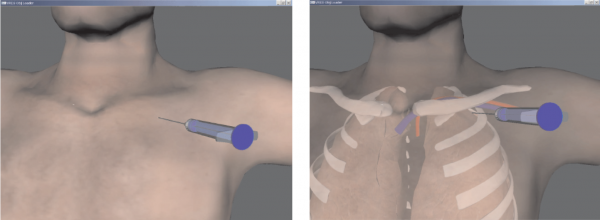Haptic Display in VR-based Surgical Simulation
Overview
Effective, real-time training of health care professionals in invasive procedures is a challenging task. Furthermore, assessing in practice the acquisition of the dexterity and skills required to safely perform such operations is particularly difficult to perform objectively and reliably. The development of virtual reality (VR) simulators offers great potential toward these objectives, and can help bypass some of the difficulties associated with classical surgical training and assessment procedures.
In this context, our work focuses on developing prototype VR simulator platforms for training in a class of invasive procedures (such as paracentesis for accessing deep vessels). In particular, our goal is to evaluate the effect of haptic display in such surgical simulation procedures, both in terms of: (i) skill training (to enhance the learning curve for novice and trainees), as well as (ii) objective and reliable surgical skill assessment. Pilot experimental studies are conducted in cooperation with medical staff from collaborating hospitals and medical schools.
People
Costas Tzafestas
Publications
Tzafestas, Costas S; Birbas, Kostas; Koumpouros, Yiannis; Christopoulos, Dimitri, “Pilot Evaluation Study of a Virtual Paracentesis Simulator for Skill Training and Assessment: The Beneficial Effect of Haptic Display,” Presence: Teleoperators & Virtual Environments, 17 (2), pp. 212–229, 2008, ISBN: 10547460.

